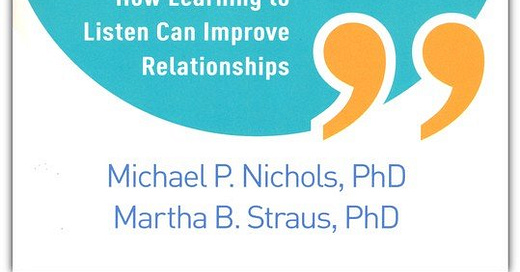Book Summary: The Lost Art of Listening: How Learning to Listen Can Improve Relationships by Michael P. Nichols and Martha B. Straus
How to Listen Like a Pro: Tips for Sales, Leadership, and Life
We’ve all experienced someone that is just waiting for the pause in a conversation to jump in and tell you all about their experience and their story. Sometimes that person has been us. This book really put into perspective that listening is a learned skill that takes time to develop, and when developed can really be transformational in your relationships, both personal and business.
The book The Lost Art of Listening: How Learning to Listen Can Improve Relationships by Michael P. Nichols and Martha B. Straus argues that listening is a skill that is essential for strong relationships, but that it is a skill that many people have not learned or mastered.
The authors define listening as "paying attention to what the other person is saying, both verbally and nonverbally, and trying to understand their meaning." They argue that listening is more than just hearing what the other person is saying; it is also about understanding their feelings, their perspective, and their needs.
Nichols and Straus identify three types of listening:
Passive listening: This is the most common type of listening, and it involves simply hearing what the other person is saying without really paying attention or trying to understand.
Active listening: This type of listening involves paying attention to the other person's words and body language, and trying to understand their meaning. Active listeners also ask clarifying questions and summarize what the other person has said to ensure that they understand.
Empathic listening: This type of listening goes beyond active listening to try to understand the other person's feelings and perspective. Empathic listeners put themselves in the other person's shoes and try to see the world from their point of view.
The authors argue that empathic listening is the most important type of listening for building strong relationships. When we listen empathically, we show the other person that we care about them and that we are trying to understand them. This can help to build trust and intimacy.
4 tips that I took away from the book:
Be present: Avoid distractions and focus on the person speaking.
Pay attention to body language: Observe the speaker's body language to understand their message.
Ask clarifying questions: Show interest in the other person by asking questions to ensure understanding.
Summarize what the other person has said: Demonstrate active listening by summarizing what the speaker has said to show that you care about their message.
The Lost Art of Listening was an incredibly valuable resource for me. I highly recommend it to anyone who wants to improve their listening skills and build stronger relationships. It will also level up your sales and leadership game immensely.




